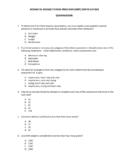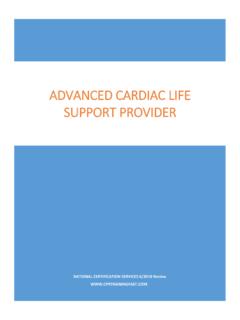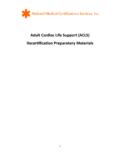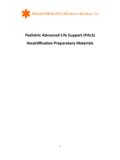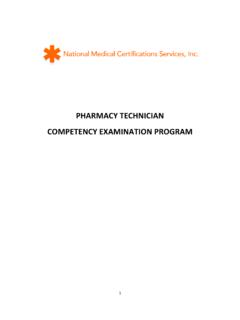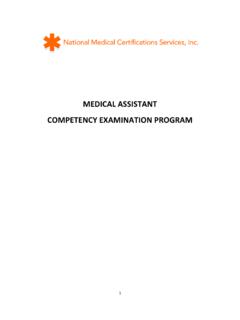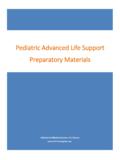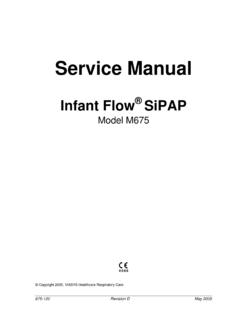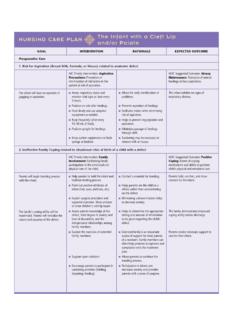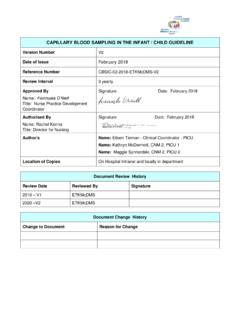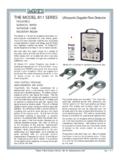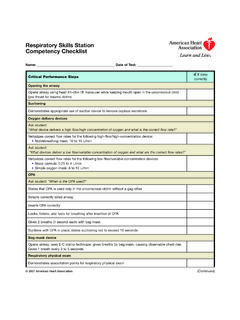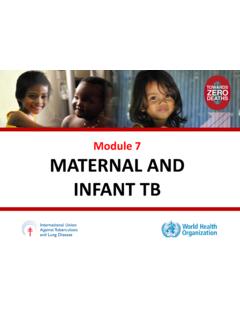Transcription of NEONATAL RESUSCITATION PROVIDER (NRP) …
1 NEONATAL RESUSCITATION PROVIDER (NRP) RECERTIFICATION. TABLE OF CONTENTS. NEONATAL FLOW ALGORITHM .2. INTRODUCTION 3. ANTICIPATION OF RESUSCITATION 4. TEMPERATURE CONTROL .4. CLEARING THE AIRWAY OF MECONIUM 5. PERIODIC EVALUATION AT 30-SECOND INTERVALS ..5. ADMINISTRATION OF OXYGEN 6. POSITIVE-PRESSURE VENTILATION ..6. INITIAL BREATHS AND ASSISTED VENTILATION ..6. DEVICES ..7. ASSISTED VENTILATION OF PRETERM INFANTS ..7. ENDOTRACHEAL TUBE PLACEMENT 8. CHEST COMPRESSIONS 9. MEDICATIONS ..9. ROUTE AND DOSE OF EPINEPHRINE ADMINISTRATION.
2 10. VOLUME EXPANSION..10. POSTRESUSCITATION CARE .10. GLUCOSE ..10. INDUCED HYPOTHERMIA ..11. NEONATAL Flow Algorithm NEONATAL RESUSCITATION PROVIDER (NRP) RECERTIFICATION. INTRODUCTION. Newborn and neonate apply to any infant during initial hospitalization. Newly born . applies specifically to an infant at the time of birth. Nearly 10% of newborns require some assistance to begin breathing at birth. Approximately 1%. require extensive resuscitative measures. Although the vast majority of newly born infants do not require intervention to make the transition from intrauterine to extrauterine life, because of the large number of births, a sizable number will require some degree of RESUSCITATION .
3 Newly born infants not requiring RESUSCITATION can generally be identified by a rapid assessment of the following 4 characteristics: Was the infant born after a full-term gestation? Is the amniotic fluid clear of meconium and evidence of infection? Is the infant breathing or crying? Does the infant have good muscle tone? If the answer to all 4 of these questions is "yes," the infant does not need RESUSCITATION and should not be separated from the mother. The infant can be dried, placed directly on the mother's chest, and covered with dry linen to maintain temperature.
4 Observation of breathing, activity, and color should be ongoing. If the answer to any of these assessment questions is "no," there is general agreement that the infant should receive 1 or more of the following 4 categories of action in sequence: A. Initial steps in stabilization (provide warmth, position, clear airway, dry, stimulate, reposition). B. Ventilation C. Chest compressions D. Administration of epinephrine and/or volume expansion The decision to progress from one category to the next is determined by the simultaneous assessment of 3 vital signs: respirations, heart rate, and color.
5 Approximately 30 seconds is allotted to complete each step, reevaluate, and decide whether to progress to the next step. ANTICIPATION OF RESUSCITATION . One person at the delivery should be responsible for the care of the infant and must be capable of initiating RESUSCITATION , including administration of positive-pressure ventilation and chest compressions. Either that person or someone else who is immediately available should have the skills required to perform a complete RESUSCITATION , including endotracheal intubation and administration of medications.
6 If a preterm delivery (<37 weeks of gestation) is expected, special preparations will be required. Preterm infants have immature lungs that may be more difficult to ventilate and are also more vulnerable to injury by positive-pressure ventilation. Preterm infants also have immature blood vessels in the brain that are prone to hemorrhage; thin skin and a large surface area, which contribute to rapid heat loss; increased susceptibility to infection; and increased risk of hypovolemic shock caused by small blood volume. TEMPERATURE CONTROL.
7 Very low birth weight (<1500 g) preterm infants are likely to become hypothermic despite the use of traditional techniques for decreasing heat loss (level of evidence). For this reason it is recommended that additional warming techniques be used, such as covering the infant in plastic wrapping (food-grade, heat-resistant plastic) and placing him or her under radiant heat. Temperature must be monitored closely because of the slight but described risk of hyperthermia with this technique. Other techniques to maintain temperature during stabilization of the infant in the delivery room (eg, drying and swaddling, warming pads, increased environmental temperature, placing the infant skin-to-skin with the mother and covering both with a blanket) have been used but they have not been evaluated in controlled trials nor compared with the plastic-wrap technique for premature infants.
8 All RESUSCITATION procedures, including endotracheal intubation, chest compression, and insertion of lines, can be performed with these temperature-controlling interventions in place. CLEARING THE AIRWAY OF MECONIUM. Aspiration of meconium before delivery, during birth, or during RESUSCITATION can cause severe aspiration pneumonia. One obstetrical technique to try to decrease aspiration has been to suction meconium from the infant 's airway after delivery of the head but before delivery of the shoulders (intrapartum suctioning). Although some studies suggest that intrapartum suctioning might be effective for decreasing the risk of aspiration syndrome, subsequent evidence from a large multicenter randomized trial did not show such an effect.
9 Therefore, current recommendations no longer advise routine intrapartum oropharyngeal and nasopharyngeal suctioning for infants born to mothers with meconium staining of amniotic fluid. Traditional teaching recommended that meconium-stained infants have endotracheal intubation immediately following birth and that suction be applied to the endotracheal tube as it is withdrawn. Randomized, controlled trials have shown that this practice offers no benefit if the infant is vigorous. A vigorous infant is defined as one who has strong respiratory efforts, good muscle tone, and a heart rate >100 beats per minute (bpm).
10 Endotracheal suctioning for infants who are not vigorous should be performed immediately after birth. PERIODIC EVALUATION AT 30-SECOND INTERVALS. After the immediate post birth assessment and administration of initial steps, further resuscitative efforts should be guided by simultaneous assessment of respirations, heart rate, and color. After initial respiratory efforts the newly born infant should be able to establish regular respirations that are sufficient to improve color and maintain a heart rate >100 bpm. Gasping and apnea indicate the need for assisted ventilation.

